Yates Account
Join now
Create a Yates account today!
Sign up to join the Yates Garden Club for monthly e-mails packed with seasonal inspiration, tips for success & exclusive promotions.
Plus if you’re a Garden Club member you can take part in the Yates Growing Community - a blog to share successes, get advice & win prizes in fun challenges along the way!

Forgot password
Enter the email address associated with your account, and we'll email you a new password.

What is Blossom End Rot (Tomatoes)
A common disorder in tomatoes is blossom-end rot in which the fruit becomes sunken and blackened. This condition is caused by lack of calcium in the developing fruit.
Over-watering should be avoided, however, because root absorption may be less efficient.
Symptoms
Black and sunken rotted sections at base of fruit.
How to protect your plants
Blossom-end rot is aggravated by moisture stress in very hot weather, so regular watering and mulching of the surface will help control the problem. An application of lime or gypsum (calcium sulfate) to the bed before planting will lessen the incidence of this disorder.
Plants impacted
- Tomatoes















Share
Share this article on social media